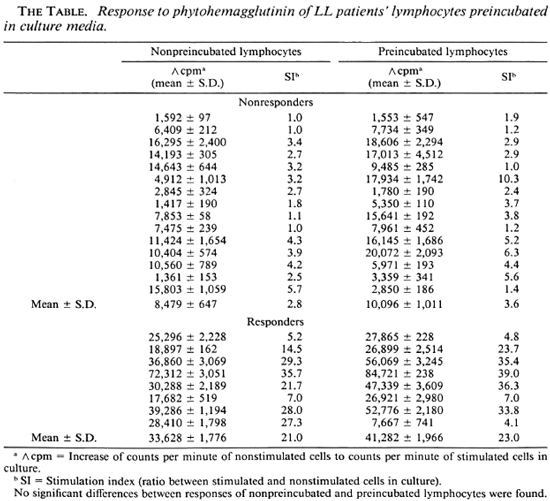- Volume 59 , Number 3
- Page: 480–2
Response to phytohemagglutinin of LL patients' lymphocytes preincubated in culture media
To the Editor:
Patients with leprosy present a well-known, wide spectrum of clinical manifestations (1) - Recently, we have published that lymphocytes from lepromatous (LL) patients stimulated with T mitogens are deficient in the synthesis of interleukin-2 (IL-2). However, the cells possess receptors for IL-2 (3,4). Mohagheghpour, et al. (6) have published that the failure of T lymphocytes from LL patients to respond to Mycobacterium leprae was associated with the defective expression of IL-2 receptors, and that this deficiency was not corrected by exogenous IL-2. Later, they reported (5) that when T lymphocytes from LL patients were preincubated in culture media for 48 hr and then stimulated with specific antigen, the cells recovered their ability to proliferate.
According to the above, we wondered if T cells from LL patients were also able to recover their capacity of proliferation when they were preincubated in culture media and then stimulated with a nonspecific T mitogen, such as phytohemagglutinin (PHA).
Study subjects. Based on Mohagheghpour, et al.'s patients' classifications (5) as "responders" and "nonresponders," we tested 23 patients (8 "responders" and 15 "nonresponders") from the Instituto Dermatológico at Guadalajara, Jalisco, Mexico, diagnosed as having LL according to international criteria (7).
Mononuclear cells. Heparinizcd blood (20 IU/ml) was obtained from each subject by venipuncture. After ccntrifugation on a Ficoll-hypaque gradient (1), the mononuclear cells were recovered and washed. The cells were then resuspended in RPMI 1640 culture medium (Sigma Chemical Company, St. Louis, Missouri, U.S.A.) and supplemented as previously reported (4).
Lymphoproliferation assay. To 2 x 105 mononuclear cells, 10 μg/ml PHA or supplemented RPMI 1640 medium was added. The cultures were incubated for 48 hr at 37ºC in a mixture of 95% air-5% CO2. Thereafter they were pulsed with 1 μCi3H-thymidine (specific activity 6.7 Ci/μmole; New England Nuclear, Boston, Massachusetts, U.S.A.). After 24-hr incubation, the cells were harvested, and the incorporation of 3H-thymidine was measured in a Packard beta counter (4).
Preincubation. Simultaneously, 2 x 105 mononuclear cells were incubated for 48 hr at 37ºC in a mixture of 95% air-5% CO2.
Thereafter they were assayed for lymphoproliferation as mentioned above.
The results from the eight patients of the "responder" group showed that in 2 (patients nos. 2 and 5) of the 8 patients the T cells increased their proliferation capacity (The Table). On the other hand, T lymphocytes from only 1 (patient no. 6) of the 15 LL patients of the "nonresponder" group did not recover that capacity.

Mohagheghpour, et al. (5) have shown that the inability of T lymphocytes from LL patients to proliferate in response to specific antigen was reversible if the cells were preincubated in culture medium alone for 48 hr. This fact suggests that in those conditions an excess of M. leprae antigen is released or that the cell surface receptors arc re-expressed. Based on this study (5), we tried to ascertain whether the inability of T lymphocytes from LL patients to proliferate in response to PHA stimulation was also reversible by preincubating those cells.
This hypothesis was not confirmed; our results showed that in only 3 of 23 cases did T lymphocytes from LL patients recover proliferation capacity. These results are not in contradiction with those obtained by Mo-hagheghpour, et al. who used specific antigen for proliferation of T cells. They only show that PHA cannot induce proliferation under the above-mentioned conditions, that perhaps the failure of T lymphocytes to respond to the mitogen stimulus is due to inadequate calcium metabolism, T-cell cycle and IL-2 synthesis (8) and not to the steric obstruction of the receptor to PHA with M. leprae antigen.
- Mary Fafutis-Morris, M.Sc.
Fernando Alfaro-Bustamante, M.Sc.
Amado González-Mendoza, M.D.
Roberto Morales-Ortiz, M.D.
Alfonso E. Islas-Rodriguez, M.Sc.
Centro de Investigaciónen Inmunología y Dermatología
Universidad de Guadalajara
Apartado Postal 51-189
Col. Las Aquilas
Guadalajara, Jalisco 45080, Mexico
Reprint requests to A. E. Islas-Rodriguez.
REFERENCES
1. Boyum, A. Isolation of mononuclear cells and granulocytes from human blood. Scand. J. Clin. Lab. Invest. 21 Suppl. 197(1988)77-85.
2. Bullock, W. E. Leprosy: a model of immunological perturbation in chronic infection. J. Infect. Dis. 137(1981)341-354.
3. Fafutis-Morris, M., Mejia-Arreguin, S., Gonzalez-Mendoza, A., Morales-Ortiz, R. and Islas-Rodriguez, A. E. Detection of interlcukin-2 receptor (IL-2r) by indirect immunofluorescence with anti-Tac monoclonal antibody on the surface of T lymphocytes from patients with lepromatous leprosy. (Letter) Int. J. Lepr. 58(1990)126-128.
4. Islas-Rodriguez, A. E., Morales-Ortiz, R., Fafutis-Morris, M., Gonzalez-Mendoza, A. and Ortiz-Ortiz, L. Deficiency in the biosynthesis of interleukin-2 (IL-2) and functional presence of the IL-2 receptor in lepromatous leprosy. (Letter) Int. J. Lepr. 55(1987)566-569.
5. Mohagheghpour, N., Gelber, R. H. and Engle-man, E. G. T cell defect in lepromatous leprosy is reversible in vitro in the absence of exogenous growth factors. J. Immunol. 138(1987)570-574.
6. Mohagheghpour, N., Gelber, R. H., Larrick, J. W., Sasaki, D. T., Brennan, P. J. and Engleman, E. G, Defective cell-mediated immunity in leprosy: a failure of T cells from lepromatous leprosy patients to respond to Mycobacterium leprae is associated with the defective expression of interleukin-2 receptors and is not reconstituted by interleukin-2. J. Immunol. 135(1985)1433-1449.
7. Ridley, D. S. and Jopling, W. H. Classification of leprosy according to immunity; a five-group system. Int. J. Lepr. 34(1966)255-273.
8. Theodorou, I. D., Bousmell, L., Calvo, C.-F., Gouy, H., Beral, H. M. and Debre, P. CD1 stimulation of human T cell lines induces a rapid increase in the intracellular free Ca2+ concentration and the production of IL-2. J. Immunol. 144(1990)2518-2523.